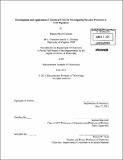Development and application of chemical tools for investigating dynamic processes in cell migration
Author(s)
Goguen, Brenda Nicole
DownloadFull printable version (30.56Mb)
Other Contributors
Massachusetts Institute of Technology. Dept. of Chemistry.
Advisor
Barbara Imperiali.
Terms of use
Metadata
Show full item recordAbstract
Cell migration is a dynamic process essential for many fundamental physiological functions, including wound repair and the immune response. Migration relies on precisely orchestrated events that are regulated in a spatially and temporally controlled manner. Most traditional approaches for studying migration, such as genetic methods or the use of chemical inhibitors, do not offer insight into these important components of protein function. However, chemical tools, which function on a more rapid timescale and in localized regions of the cell, are capable of providing real-time information about protein activity. Herein, the development and application of chemical approaches to investigate proteins central to cell migration are presented. Myosin II, an ATPase motor protein required for cell motility, is activated by phosphorylation of the associated myosin regulatory light chain (mRLC) protein at Serl9. To generate a photoactivated mRLC variant that offers control over the timing and localization of myosin activity, the mRLC has been prepared by expressed protein ligation for the site-specific incorporation of 1-(2-nitrophenyl)ethyl (NPE)-caged phosphoserine at position 19. The NPE caging group masks the phosphate functionality and inhibits protein function until irradiation at 365 nm releases the native phospho-mRLC to restore myosin activity. Introduction of the caged mRLC into cells enables interrogation of the role of myosin in coordinating cell contractility. To expand the scope of the caging approaches, the NPE caging group has been applied in concert with the [7-(diethylamino)coumarin-4-yl]methyl (DEACM) group, which is released by irradiation at 420 nm, to enable two different phosphopeptides to be sequentially released within one system. Preparation of DEACM-caged phosphoamino acid building blocks for solid phase peptide synthesis enables convenient incorporation of these residues into peptides and proteins. This sequential uncaging approach has been exploited to initiate and subsequently inhibit a biochemical reaction in an enzyme-independent fashion using two wavelengths of light. Finally, a fluorogenic sensor to monitor the real-time activity of the GTPase Cdc42, an essential regulator of migratory processes, has been developed. The solvatochromic fluorophore 4-N,N-dimethylamino-1,8-naphthalimide has been incorporated into a protein fragment that binds only the activated conformation of Cdc42. This sensor reports Cdc42 activation through significant increases in fluorescence and has been applied in a cellular context to monitor endogenous Cdc42 activity. This fluorogenic sensor and the caging approaches together demonstrate the power of chemical tools for interrogating diverse aspects of cell migration.
Description
Thesis (Ph. D.)--Massachusetts Institute of Technology, Dept. of Chemistry, 2011. Cataloged from PDF version of thesis. Includes bibliographical references.
Date issued
2011Department
Massachusetts Institute of Technology. Department of ChemistryPublisher
Massachusetts Institute of Technology
Keywords
Chemistry.